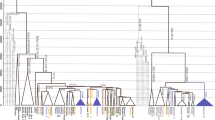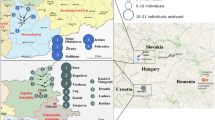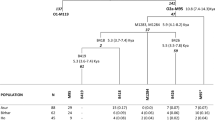Abstract
Many single-nucleotide polymorphisms (SNPs) in the non-recombining region of the human Y chromosome have been described in the last decade. High-coverage sequencing has helped to characterize new SNPs, which has in turn increased the level of detail in paternal phylogenies. However, these paternal lineages still provide insufficient information on population history and demography, especially for Native Americans. The present study aimed to identify informative paternal sublineages derived from the main founder lineage of the Americas—haplogroup Q-L54—in a sample of 1841 native South Americans. For this purpose, we used a Y-chromosomal genotyping multiplex platform and conventional genotyping methods to validate 34 new SNPs that were identified in the present study by sequencing, together with many Y-SNPs previously described in the literature. We updated the haplogroup Q phylogeny and identified two new Q-M3 and three new Q-L54*(xM3) sublineages defined by five informative SNPs, designated SA04, SA05, SA02, SA03 and SA29. Within the Q-M3, sublineage Q-SA04 was mostly found in individuals from ethnic groups belonging to the Tukanoan linguistic family in the northwest Amazon, whereas sublineage Q-SA05 was found in Peruvian and Bolivian Amazon ethnic groups. Within Q-L54*, the derived sublineages Q-SA03 and Q-SA02 were exclusively found among Coyaima individuals (Cariban linguistic family) from Colombia, while Q-SA29 was found only in Maxacali individuals (Jean linguistic family) from southeast Brazil. Furthermore, we validated the usefulness of several published SNPs among indigenous South Americans. This new Y chromosome haplogroup Q phylogeny offers an informative paternal genealogy to investigate the pre-Columbian history of South America.
Similar content being viewed by others
Log in or create a free account to read this content
Gain free access to this article, as well as selected content from this journal and more on nature.com
or
Change history
31 March 2016
This article has been corrected since Advance Online Publication, and an erratum is also printed in this issue.
References
Y Chromosome Consortium A nomenclature system for the tree of human Y-chromosomal binary haplogroups. Genome Res. 12, 339–348 (2002).
Skaletsky, H., Kuroda-Kawaguchi, T., Minx, P. J., Cordum, H. S., Hillier, L., Brown, L. G. et al. The male-specific region of the human Y chromosome is a mosaic of discrete sequence classes. Nature 423, 825–837 (2003).
Wei, W., Ayub, Q., Chen, Y., McCarthy, S., Hou, Y., Carbone, I. et al. A calibrated human Y-chromosomal phylogeny based on resequencing. Genome Res. 23, 388–395 (2013).
Pena, S. D., Santos, F. R., Bianchi, N. O., Bravi, C. M., Carnese, F. R., Rothhammer, F. et al. A major founder Y-chromosome haplotype in Amerindians. Nat. Genet. 11, 15–16 (1995).
Santos, F. R., Hurtz, M. H., Coimbra, C. E. A., Santos, R. V., Salzano, F. M. & Pena, S. D. Further evidence of existence of major founder Y chromosome haplotype in Amerindians. Braz. J. Genet. 18, 669–672 (1995).
Santos, F. R., Rodriguez-Delfin, L., Pena, S. D., Moore, J. & Weiss, K. M. North and South Amerindians may have the same major founder Y chromosome haplotype. Am. J. Hum. Genet. 58, 1369–1370 (1996).
Santos, F. R., Pandya, A., Tyler-Smith, C., Pena, S. D., Schanfield, M., Leonard, W. R. et al. The central Siberian origin for native American Y chromosomes. Am. J. Hum. Genet. 64, 619–628 (1999).
Underhill, P. A., Jin, L., Lin, A. A., Mehdi, S. Q., Jenkins, T., Vollrath, D. et al. Detection of numerous Y chromosome biallelic polymorphisms by denaturing high-performance liquid chromatography. Genome Res. 7, 996–1005 (1997).
Karafet, T. M., Zegura, S. L., Posukh, O., Osipova, L., Bergen, A., Long, J. et al. Ancestral Asian source(s) of new world Y-chromosome founder haplotypes. Am. J. Hum. Genet. 64, 817–831 (1999).
Karafet, T. M., Mendez, F. L., Meilerman, M. B., Underhill, P. A., Zegura, S. L. & Hammer, M. F. New binary polymorphisms reshape and increase resolution of the human Y chromosomal haplogroup tree. Genome Res. 18, 830–838 (2008).
Zegura, S. L., Karafet, T. M., Zhivotovsky, L. A. & Hammer, M. F. High-resolution SNPs and microsatellite haplotypes point to a single, recent entry of native American Y chromosomes into the Americas. Mol. Biol. Evol. 21, 164–175 (2004).
Dulik, M. C., Owings, A. C., Gaieski, J. B., Vilar, M. G., Andre, A., Lennie, C. et al. Y-chromosome analysis reveals genetic divergence and new founding native lineages in Athapaskan- and Eskimoan-speaking populations. Proc. Natl Acad. Sci. USA 109, 8471–8476 (2012a).
Dulik, M. C., Zhadanov, S. I., Osipova, L. P., Askapuli, A., Gau, L., Gokcumen, O. et al. Mitochondrial DNA and Y chromosome variation provides evidence for a recent common ancestry between native Americans and Indigenous Altaians. Am. J. Hum. Genet. 90, 229–246 (2012b).
Bisso-Machado, R., Jota, M. S., Ramallo, V., Paixão-Côrtes, V. R., Lacerda, D. R., Salzano, F. M. et al. Distribution of Y-chromosome Q lineages in native Americans. Am. J. Hum. Biol. 23, 563–566 (2011).
Bisso-Machado, R., Bortolini, M. C. & Salzano, F. M. Uniparental genetic markers in South Amerindians. Genet. Mol. Biol. 35, 365–387 (2012).
Battaglia, V., Grugni, V., Perego, U. A., Angerhofer, N., Gomez-Palmieri, J. E., Woodward, S. R. et al. The first peopling of South America: new evidence from Y-chromosome haplogroup Q. PLoS ONE 8, e71390 (2013).
Roewer, L., Nothnagel, M., Gusmão, L., Gomes, V., González, M., Corach, D. et al. Continent-wide decoupling of Y-chromosomal genetic variation from language and geography in native South Americans. PLoS Genet. 9, e1003460 (2013).
Sandoval, J. R., Lacerda, D. R., Jota, M. S., Salazar-Granara, A., Vieira, P. P., Acosta, O. et al. The genetic history of indigenous populations of the Peruvian and Bolivian Altiplano: the legacy of the Uros. PLoS One 8, e73006 (2013).
Geppert, M., Baeta, M., Núñez, C., Martínez-Jarreta, B., Zweynert, S., Cruz, O. W. et al. Hierarchical Y-SNP assay to study the hidden diversity and phylogenetic relationship of native populations in South America. Forensic Sci. Int. Genet. 5, 100–104 (2011).
Geppert, M., Ayub, Q., Xue, Y., Santos, S., Ribeiro-Dos-Santos, A., Baeta, M. et al. Identification of new SNPs in native South American populations by resequencing the Y chromosome. Forensic Sci. Int. Genet. 15, 111–114 (2015).
Mezzavilla, M., Geppert, M., Tyler-Smith, C., Roewer, L. & Xue, Y. Insights into the origin of rare haplogroup C3* Y chromosomes in South America from high-density autosomal SNP genotyping. Forensic Sci. Int. Genet. 15, 115–120 (2015).
Hallast, P., Batini, C., Zadik, D., Maisano Delser, P., Wetton, J. H., Arroyo-Pardo, E. et al. The Y-chromosome tree bursts into leaf: 13,000 high-confidence SNPs covering the majority of known clades. Mol. Biol. Evol. 32, 661–673 (2015).
Seielstad, M., Yuldasheva, N., Singh, N., Underhill, P., Oefner, P., Shen, P. et al. A novel Y-chromosome variant puts an upper limit on the timing of first entry into the Americas. Am. J. Hum. Genet. 73, 700–705 (2003).
Jota, M. S., Lacerda, D. R., Sandoval, J. R., Vieira, P. P., Santos-Lopes, S. S., Bisso-Machado, R. et al. A new subhaplogroup of native American Y-Chromosomes from the Andes. Am. J. Phys. Anthropol. 146, 553–559 (2011).
Zhong, H., Shi, H., Qi, X. B., Xiao, C. J., Jin, L., Ma, R. Z. et al. Global distribution of Y-chromosome haplogroup C reveals the prehistoric migration routes of African exodus and early settlement in East Asia. J. Hum. Genet. 55, 428–435 (2010).
Drmanac, R., Sparks, A. B., Callow, M. J., Halpern, A. L., Burns, N. L., Kermani, B. G. et al. Human genome sequencing using unchained base reads on self-assembling DNA nanoarrays. Science 327, 78–81 (2010).
Poznik, G. D., Henn, B. M., Yee, M. C., Sliwerska, E., Euskirchen, G. M., Lin, A. A. et al. Sequencing Y chromosomes resolves discrepancy in time to common ancestor of males versus females. Science 341, 562–565 (2013).
Scozzari, R., Massaia, A., Trombetta, B., Bellusci, G., Myres, N. M., Novelletto, A. et al. An unbiased resource of novel SNP markers provides a new chronology for the human Y chromosome and reveals a deep phylogenetic structure in Africa. Genome Res. 24, 535–544 (2014).
Van Oven, M., Van Geystelen, A., Kayser, M., Decorte, R. & Larmuseau, M. H. Seeing the wood for the trees: a minimal reference phylogeny for the human Y chromosome. Hum. Mutat. 35, 187–191 (2014).
Gusmão, L., Butler, J. M., Carracedo, A., Gill, P., Kayser, M., Mayr, W. R. et al. DNA Commission of the International Society of Forensic Genetics (ISFG): an update of the recommendations on the use of Y-STRs in forensic analysis. Forensic Sci. Int. 157, 187–197 (2006).
Santos, F. R. & Tyler-Smith, C. Reading the human Y chromosome: the emerging DNA markers and human genetic history. Braz. J. Genet. 19, 665–670 (1996).
Zerjal, T., Dashnyam, B., Pandya, A., Kayser, M., Roewer, L., Santos, F. R. et al. Genetic relationships of Asians and Northern Europeans, revealed by Y-chromosomal DNA analysis. Am. J. Hum. Genet. 60, 1174–1183 (1997).
Tarazona-Santos, E., Carvalho-Silva, D. R., Pettener, D., Luiselli, D., De Stefano, G. F., Labarga, C. M. et al. Genetic differentiation in South Amerindians is related to environmental and cultural diversity: evidence from the Y chromosome. Am. J. Hum. Genet. 68, 1485–1496 (2001).
Bortolini, M. C., Salzano, F. M., Thomas, M. G., Stuart, S., Nasanen, S. P., Bau, C. H. et al. Y-chromosome evidence for differing ancient demographic histories in the Americas. Am. J. Hum. Genet. 73, 524–539 (2003).
Bailliet, G., Ramallo, V., Muzzio, M., García, A., Santos, M. R., Alfaro, E. L. et al. Brief communication: Restricted geographic distribution for Y-Q* paragroup in South America. Am. J. Phys. Anthropol. 140, 578–582 (2009).
Mulero, J. J., Chang, C. W., Calandro, L. M., Green, R. L., Li, Y., Johnson, C. L. et al. Development and validation of the AmpFlSTR Yfiler PCR amplification kit: a male specific, single amplification 17 Y-STR multiplex system. J. Forensic Sci. 51, 64–75 (2006).
Bandelt, H. J., Forster, P. & Röhl, A. Median-joining networks for inferring intraspecific phylogenies. Mol. Biol. Evol. 16, 37–48 (1999).
Shen, P., Lavi, T., Kivisild, T., Chou, V., Sengun, D., Gefel, D. et al. Reconstruction of patrilineages and matrilineages of Samaritans and other Israeli populations from Y-chromosome and mitochondrial DNA sequence variation. Hum. Mutat. 24, 248–260 (2004).
Sengupta, S., Zhivotovsky, L. A., King, R., Mehdi, S. Q., Edmonds, C. A., Chow, C. E. et al. Polarity and temporality of high-resolution y-chromosome distributions in India identify both indigenous and exogenous expansions and reveal minor genetic influence of Central Asian pastoralists. Am. J. Hum. Genet. 78, 202–221 (2006).
Deng, W., Shi, B., He, X., Zhang, Z., Xu, J., Li, B. et al. Evolution and migration history of the Chinese population inferred from Chinese Y-chromosome evidence. J. Hum. Genet. 49, 339–348 (2004).
Underhill, P. A., Jin, L., Zemans, R., Oefner, P. J. & Cavalli-Sforza, L. L. A pre-Columbian Y chromosome-specific transition and its implications for human evolutionary history. Proc. Natl Acad. Sci. USA 93, 196–200 (1996).
Underhill, P. A., Passarino, G., Lin, A. A., Shen, P., Mirazón Lahr, M., Foley, R. A. et al. The phylogeography of Y chromosome binary haplotypes and the origins of modern human populations. Ann. Hum. Genet. 65, 43–62 (2001).
Wilder, J. A., Kingan, S. B., Mobasher, Z., Pilkington, M. M. & Hammer, M. F. Global patterns of human mitochondrial DNA and Y-chromosome structure are not influenced by higher migration rates of females versus males. Nat. Genet. 36, 1122–1125 (2004).
Ayub, Q., Jostins, L., Xue, Y., Turner, D. & Tyler-Smith, C. The 1000 Genomes Consortium Next generation sequencing and the era of personal Y genomes. Genome Biol. 11 (Suppl 1), O2 (2010).
Thomas Krahn/FTDNA (2001) https://www.familytreedna.com. Accessed 6 December 2012.
Complete Genomics (2013) http://www.completegenomics.com. Accessed 16 January 2013.
International Society of Genetic Genealogy. ISOGG Y-DNA Haplogroup Tree 2011, Version 9.129. (2011) http://isogg.org/tree. Accessed 4 December 2012.
Elhaik, E., Greenspan, E., Staats, S., Krahn, T., Tyler-Smith, C., Xue, Y. et al. The GenoChip: a new tool for genetic anthropology. Genome Biol. Evol. 5, 1021–1031 (2013).
Shen, R., Fan, J. B., Campbell, D., Chang, W., Chen, J., Doucet, D. et al. High-throughput SNP genotyping on universal bead arrays. Mutat. Res. 573, 70–82 (2005).
Lin, C. H., Yeakley, J. M., McDaniel, T. K. & Shen, R. Medium- to high-throughput SNP genotyping using VeraCode microbeads. Methods Mol. Biol. 496, 129–142 (2009).
Zhivotovsky, L. A., Underhill, P. A., Cinnioğlu, C., Kayser, M., Morar, B., Kivisild, T. et al. The effective mutation rate at Y chromosome short tandem repeats, with application to human population-divergence time. Am. J. Hum. Genet. 74, 50–61 (2004).
Wright-Robin, M. História dos Índios do Brasil (org. Carneiro da Cunha, Manuela) 253–278 (Companhia das Letras, São Paulo, SP, Brazil, 1992).
Scliar, M. O., Gouveia, M. H., Benazzo, A., Ghirotto, S., Fagundes, N. J., Leal, T. P. et al. Bayesian inferences suggest that Amazon Yunga natives diverged from Andeans less than 5000 ybp: implications for South American prehistory. BMC Evol. Biol. 14, 174 (2014).
Busby, G. B., Brisighelli, F., Sánchez-Diz, P., Ramos-Luis, E., Martinez-Cadenas, C., Thomas, M. G. et al. The peopling of Europe and the cautionary tale of Y chromosome lineage R-M269. Proc. Biol. Sci. 279, 884–892 (2012).
Bergen, A. W., Wang, C. Y., Tsai, J., Jefferson, K., Dey, C., Smith, K. D. et al. An Asian-Native American paternal lineage identified by RPS4Y resequencing and by microsatellite haplotyping. Ann Hum Genet. 63, 63–80 (1999).
Cinnioğlu, C., King, R., Kivisild, T., Kalfoğlu, E., Atasoy, S., Cavalleri, G. L. et al. Excavating Y-chromosome haplotype strata in Anatolia. Hum Genet. 114, 127–148 (2003).
Hudjashov, G., Kivisild, T., Underhill, P. A., Endicott, P., Sanchez, J. J., Lin, A. A. et al. Revealing the prehistoric settlement of Australia by Y chromosome and mtDNA analysis. Proc Natl Acad Sci U S A 104, 8726–8730 (2007).
Myres, N. M., Rootsi, S., Lin, A. A., Järve, M., King, R. J., Kutuev, I. et al. A major Y-chromosome haplogroup R1b Holocene era founder effect in Central and Western Europe. Eur J Hum Genet 19, 95–101 (2010).
Seielstad, M. T., Hebert, J. M., Lin, A. A., Underhill, P. A., Ibrahim, M., Vollrath, D. et al. Construction of human Y-chromosomal haplotypes using a new polymorphic A to G transition. Hum Mol Genet. 3, 2159–2161 (1994).
Acknowledgements
We thank Joice Pedroso, Fabiano Assunção and Sibelle T Vilaça for technical help in some experiments and analysis, and to Davidson Campos for drawing of map figures. We thank the Laboratório Multiusuário de Genômica of Universidade Federal de Minas Gerais (Brazil) for the use of the BeadXpress. We received financial support from the National Geographic Society (USA) and the National Research Council (CNPq) and Fundação de Apoio à Pesquisa de Minas Gerais (FAPEMIG) (Brazil). QA and CTS are supported by The Wellcome Trust (098051), and FRS by CNPq.
Author information
Authors and Affiliations
Consortia
Corresponding author
Ethics declarations
Competing interests
The authors declare no conflict of interest.
Additional information
The Genographic Consortium Li Jin, Hui Li, & Shilin Li (Fudan University, Shanghai, China); Pandikumar Swamikrishnan (IBM, Somers, New York, United States); Asif Javed, Laxmi Parida & Ajay K Royyuru (IBM, Yorktown Heights, New York, United States); R John Mitchell (La Trobe University, Melbourne, Victoria, Australia); Pierre A Zalloua (Lebanese American University, Chouran, Beirut, Lebanon); Arun Kumar, Ganesh Prasad, Ramasamy Pitchappan, Arun Varatharajan Santhakumari (Madurai Kamaraj University, Madurai, Tamil Nadu, India); R Spencer Wells and Miguel G Vilar (National Geographic Society, Washington, District of Columbia, United States); Himla Soodyall (National Health Laboratory Service, Johannesburg, South Africa); Elena Balanovska & Oleg Balanovsky (Research Centre for Medical Genetics, Russian Academy of Medical Sciences, Moscow, Russia); Jaume Bertranpetit, Marc Haber, Marta Melé, & David Comas (Universitat Pompeu Fabra, Barcelona, Spain); Christina J Adler, Alan Cooper, Clio S I Der Sarkissian & Wolfgang Haak (University of Adelaide, South Australia, Australia); Matthew E Kaplan & Nirav C Merchant (University of Arizona, Tucson, Arizona, United States); Colin Renfrew (University of Cambridge, Cambridge, United Kingdom); Andrew C Clarke & Elizabeth A Matisoo-Smith (University of Otago, Dunedin, New Zealand); Jill B Gaieski (University of Pennsylvania, Philadelphia, Pennsylvania, United States).
Supplementary Information accompanies the paper on Journal of Human Genetics website
Supplementary information
Rights and permissions
About this article
Cite this article
Jota, M., Lacerda, D., Sandoval, J. et al. New native South American Y chromosome lineages. J Hum Genet 61, 593–603 (2016). https://doi.org/10.1038/jhg.2016.26
Received:
Revised:
Accepted:
Published:
Issue date:
DOI: https://doi.org/10.1038/jhg.2016.26
This article is cited by
-
The Pre-Columbian Peopling and Population Dispersals of South America
Journal of Archaeological Research (2021)
-
Tracing the genetic history of the ‘Cañaris’ from Ecuador and Peru using uniparental DNA markers
BMC Genomics (2020)
-
Genetic ancestry of families of putative Inka descent
Molecular Genetics and Genomics (2018)
-
The study of human Y chromosome variation through ancient DNA
Human Genetics (2017)



